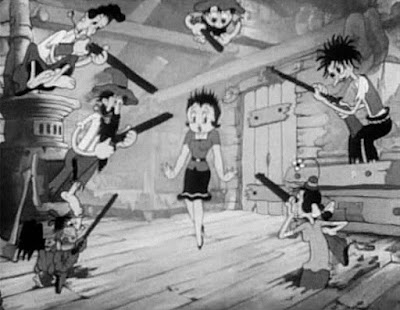Mel says: "The Hays Code literally led to Betty Boop's untimely death. They made her button up her mouth and her dress. And in the end, even her proportions changed, as she travelled down the road that led to the Uncanny Valley. I just spent a miserable afternoon watching Betty Boops Final cartoons. Betty’s image is very popular today, but few of those who wear her image on their clothes and fashion accessories actually know her story.
"To put it in a 'mutt-shell,' she began life as a dog, and not a particularly attractive one. Here she is in making her first appearance in a cartoon called Dizzy Dishes. Bimbo too looked different then.
"Soon, Betty transformed into a human. Nonetheless, she still chose Bimbo as her boyfriend. Here they are, Ahem, in bed.
"Soon Betty got much better looking, This image below presents her at her most perfect, Of all the images of betty Boop this one remains for me the most iconic. I used it on the box for a Betty Boop doll I designed half a century ago. At that moment in time, 1970, she had become virtually unknown. Thus, this was the first Betty Boop product to appear since 1939. I stumbled across one of these in mint condition on eBay, just the other night. For Twenty dollars I couldn’t resist buying it.
"Betty Boop’s career spanned a short nine years, from 1930 to 1939. Halfway through her journey, in 1934 the Hays Bureau clipped her wings. The comparative drawings below graphically demonstrate how they compelled Betty to change.
"Nonetheless, she carried on for a five more years with her attire and innocent sexuality toned down. In spite of this, her delightful voice and sparkling personality remained the same. In this latter part of her career, she stopped hanging out with animals and clowns. Bimbo and Koko both disappeared, and her world was suddenly populated with human beings of the same species as her own. She also got a puppy called Pudgy, who often stole the show. Slowly, it was all downhill from there.
"The official model sheet below conveys how Betty had changed by 1938. Her head became much smaller, she also became taller, and her proportions were more conventional. Her original outrageously stylized proportions had been easier to accept than this newer version. Now with a body that was more anatomically correct, her slightly oversized head seemed uncomfortably out of place..
"Bettys final cartoons are hard to watch. In this one from 1938, Betty, looking spanking clean, attempts to discipline a monkey. That was a high point compared to what was to follow in 1939.
"In a short titled, “Musical Mountaineers,” Betty encountered hostile hillbillies who were definitely not of the Beverly Hills variety. Fortunately, she survived, Her career was not so lucky.
"Worse still, was a 1939 cartoon called, Rhythm On The Reservation. By any standard it would be considered outrageously racist. In it, Betty wins over a menacing tribe of Native Americans by teaching them how to play musical instruments. This image reveals how dramatically Betty’s look had changed.
"In what amounted to the final indignity, the studio forced Betty to introduce her own replacement, “Sally Swing.” It appears that the studio saw Sally as a big deal.
"They even created a poster for her. They hoped that Sally would take Bettys place for the next decade. Sally’s voice was purported to be that of 15 year old Rose Marie.
"Here we see the two of them together, along with Sally’s poster, upon which Betty appears in name only."
-----
Thanks, Mel Birnkrant for sharing these fascinating guest posts about popular culture in the 1930s. For more stories of vintage character toys and the art of toy invention, visit his website.
This series:
Part 1: Materials and Workmanship of 1930s Toys
Part 2: 1930s Toys, Comic Types and Characters
Part 3: Why Did Animation Flourish in the 1930s?
Part 4: What They Cut from King Kong


















3 comments:
I thoroughly enjoyed this series of posts!
Loved this series of posts by Mel! Would love to read a book by Mel. In the meantime, does Mel recommend any books on these subjects? Thanks!
Fantastic series. Thanks to both of you.
Post a Comment